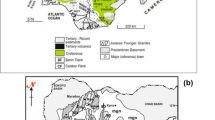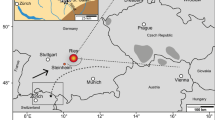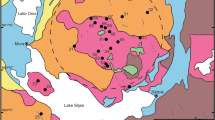Abstract
MANY lines of evidence now support the identification of the Chicxulub structure, in Mexico, as a buried impact crater and the probable source of ejecta found in Cretaceous/Tertiary (K/T) boundary sections worldwide1–8. The question remains, however, of whether there might be additional craters of K/T age, which also contributed ejecta. Shocked zircons from a K/T ejecta layer in Colorado9 preserve a primary source age of 545 ± 5 Myr, with variable degrees of isotopic resetting consistent with partial lead loss at the time of impact (65 Myr ago)10. Here we report that the impact breccia from Chicxulub contains zircons that are identical in age, texture and lead loss pattern to the Colorado zircons, and to some from the Beloc section in Haiti. U–Pb data for 18 of the 36 grains studied (from all three sites) fall on a single line as well as if they had come from a single sample. An additional source age of 418 ±6 Myr is found only in Chicxulub and Haiti, suggesting that the Haiti and Colorado ejecta might have sampled different parts of the target stratigraphy. As all the ejecta ages found so far are also found at Chicxulub, our results are consistent with this being the only significant continental K/T impact crater.
This is a preview of subscription content, access via your institution
Access options
Subscribe to this journal
Receive 51 print issues and online access
$199.00 per year
only $3.90 per issue
Buy this article
- Purchase on Springer Link
- Instant access to full article PDF
Prices may be subject to local taxes which are calculated during checkout
Similar content being viewed by others
References
Izett, G. A. Geol. Soc. Am. spec. Pap. 249, 1–90 (1990).
Sharpton, V. L., Schuraytz, B. C., Burke, K., Murali, A. V. & Ryder, G. Geol. Soc. Am. spec. Pap. 247, 349–357 (1990).
Alvarez, W., Alvarez, L. W., Asaro, F. & Michel, H. V. Geol. Soc. Am. spec. Pap. 190, 305–315 (1982).
Penfield, G. T. & Camargo, Z. A. in 51st A. Meeting Tech. Prog. Soc. Explor. Geophys. (Abstr.) 37 (1981).
Hildebrand, A. R. et al. Geology 19, 867–871 (1991).
Swisher, C. C. et al. Science 257, 954–958 (1992).
Sharpton, V. L. et al. Nature 359, 819–821 (1992).
Blum, J. D. et al. Nature 364, 325–327 (1993).
Bohor, B. F., Betterton, W. J. & Krogh, T. E. Earth planet Sci. Lett. 119, 419–424 (1993).
Krogh, T. E., Kamo, S. L. & Bohor, B. F. Earth planet. Sci. Lett. 119, 425–429 (1993).
Hitdebrand, A. R. thesis, Univ. Arizona (1992).
Lopez Ramos, E. Geologia de Mexico 2nd edn Vol. 2 (Univ. Mexico, Mexico City, 1979).
Sharpton, V. L. et al. Science 261, 1564–1567 (1993).
Krogh, T. E. Geochim. cosmochim. Acta 37, 485–494 (1973).
Davis, D. W. Can. J. Earth Sci. 19, 2141–2149 (1982).
Stacey, J. S. & Kramers, J. D. Earth planet. Sci. Lett. 34, 207–226 (1975).
Krogh, T. E. et al. Can. J. Earth Sci. 25, 442–453 (1988).
Author information
Authors and Affiliations
Rights and permissions
About this article
Cite this article
Krogh, T., Kamo, S., Sharpton, V. et al. U–Pb ages of single shocked zircons linking distal K/T ejecta to the Chicxulub crater. Nature 366, 731–734 (1993). https://doi.org/10.1038/366731a0
Received:
Accepted:
Issue Date:
DOI: https://doi.org/10.1038/366731a0
This article is cited by
-
Phase transition and melting in zircon by nanosecond shock loading
Physics and Chemistry of Minerals (2022)
-
Impact-triggered nanoscale Pb clustering and Pb loss domains in Archean zircon
Contributions to Mineralogy and Petrology (2020)
-
The Yucatan, a Laurentian or Gondwanan fragment? Geophysical and palinspastic constraints
International Journal of Earth Sciences (2014)
-
New insights into the history and origin of the southern Maya block, SE México: U–Pb–SHRIMP zircon geochronology from metamorphic rocks of the Chiapas massif
International Journal of Earth Sciences (2007)
-
Neoproterozoic?Early Paleozoic evolution of peri-Gondwanan terranes: implications for Laurentia-Gondwana connections
International Journal of Earth Sciences (2004)
Comments
By submitting a comment you agree to abide by our Terms and Community Guidelines. If you find something abusive or that does not comply with our terms or guidelines please flag it as inappropriate.



